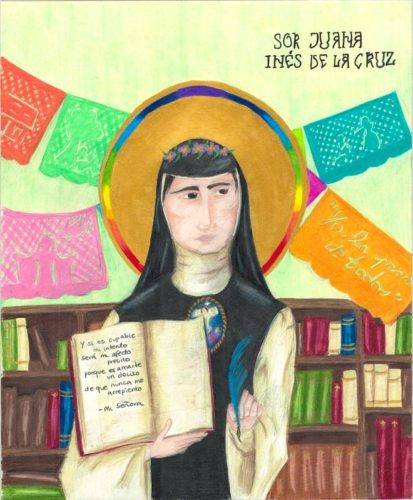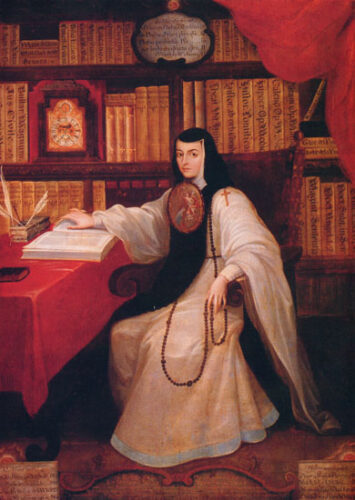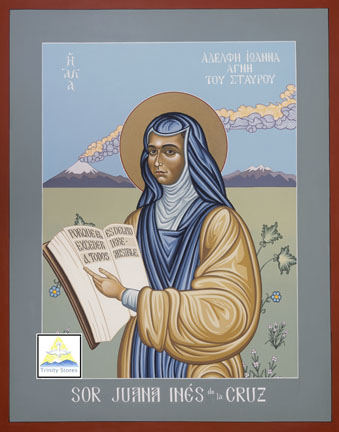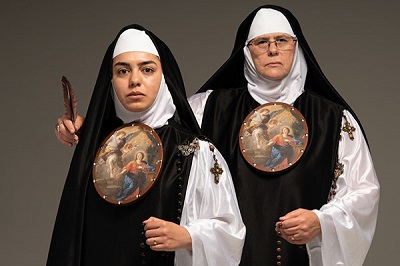Last Updated on May 3, 2025 by Kittredge Cherry

Sor Juana Inés de la Cruz was a 17th-century Mexican nun whose critically acclaimed writings include lesbian love poetry. She is considered one of the greatest Latin American poets, an early advocate of women’s rights, and some say, North America’s first lesbian feminist writer. She is so important in Mexico that her face appears on the national currency.
Sor Juana (Nov. 12, 1648 – April 17, 1695) was born out of wedlock near Mexico City in what was then New Spain. She was a witty, intellectually gifted girl who loved learning. Girls of her time were rarely educated, but she learned to read in her grandfather’s book-filled house.
When she was 16, she asked for her parents’ permission to disguise herself as a male student in order to attend university, which did not accept women. They refused, and instead she entered the convent in 1667. In her world, the convent was the only place where a woman could pursue education.
Sor Juana’s convent cell became Mexico City’s intellectual hub. Instead of an ascetic room, Sor Juana had a suite that was like a modern apartment. Her library contained an estimated 4,000 books, the largest collection in Mexico. The portrait from 1750 shows her in her amazing library, surrounded by her many books.

Sor Juana Inés de la Cruz by Miguel Cabrera, 1750 (Wikimedia Commons)
She turned her nun’s quarters into a salon, visited by the city’s intellectual elite. Among them was Countess Maria Luisa de Paredes, vicereine of Mexico. The two women became passionate friends. It’s unclear whether they were lesbians by today’s definition, but Maria Luisa inspired Sor Juana to write amorous love poems, such as:
That you’re a woman far away
is no hindrance to my love:
for the soul, as you well know,
distance and sex don’t count.

“Sor Juana and the Countess” (Sor Juana y la Virreina) by Felix d’Eon. Prints are available at his Etsy shop.
Sor Juana and the countess kiss in a painting by Felix d’Eon. Sor Juana holds a handwritten poem in her hand as they share a kiss in her extensive library. Based in Mexico City, D’Eon describes himself as a “latinx painter and activist dedicated to the art of queer love, romance, and sensuality.”
Church authorities cracked down on Sor Juana, not because of her lesbian poetry, but for “La Respuesta,” her classic defense of women’s rights in response to opposition from the clergy. Threatened by the Inquisition, Sor Juana was silenced for the final three years of her life. At age 46, she died in Mexico City after taking care of her sisters in an outbreak of plague.
It’s confusing, but Sor Juana is a different person from another famous queer nun who had a similar name: Blessed Madre Juana de la Cruz of 16th-century Spain.
She is not recognized as a saint by the male-dominated church hierarchy that she criticized, but Sor Juana holds a place in the informal communion of saints honored by LGBTQ people of faith and our allies. She is especially revered as a role model by Latina feminists.
Progressive artists and writers portray Sor Juana
Sor Juana has a rainbow halo in an icon created by queer Lutheran artist and seminary graduate Katy (Keats) Miles-Wallace as part of the “Queer Saints” series. It appears at the top of this post. In the icon, Sor Juana holds a book displaying a verse from her poem “My Lady,” which translates as:
“Let my love be ever doomed
if guilty in its intent,
for loving you is a crime
of which I will never repent.”
Behind Sor Juana is a prayer flag with a Spanish phrase that she used as her signature when the church forced her to repent: “Yo, la Peor de Todas,” (I, the worst of all).
In her Queer Saints series, Miles-Wallace presents traditional saints with queer qualities and heroes of the LGBTQ community. The icons are rooted in queer theology and in Miles-Wallace’s eclectic faith journey that began at a Baptist church in Texas and led to study at Pacific Lutheran Theological Seminary in Berkeley, California. She drew many of them on the altar of a seminary chapel. For more info, see the Q Spirit article “New icons of Queer Saints created by artist Katy Miles-Wallace.”
A solemn Sor Juana looks like a living contemporary woman with a halo in a realistic modern icon by Chicago artist Jen Casselberry. She created it for a commissioned series of seven activist/contemplative icon paintings. Giclee fine art prints of her original oil paintings are available through the Jen Casselberry Etsy Shop.
The romance between Sor Juana and Maria Luisa has long been an inspiration for authors and film makers. Poet and Chicano studies scholar Alicia Gaspar de Alba writes about it vividly in her novel “Sor Juana’s Second Dream.” Her idea of Sor Juana as a lesbian is discussed in “Sor Juana Inés de la Cruz: Feminist Reconstruction of Biography and Text” by Theresa A. Yugar.” The novel became the basis for the play “The Nun and the Countess” by Odalys Nanín.

The possibility of lesbian love among nuns is part of Juana de la Cruz’s life story as told in the illustrated book “Heavenly Homos, Etc.: Queer Icons from LGBTQ Life, Religion, and History” by Jan Haen, a Dutch artist and Roman Catholic priest in the Redemptorist order.
 Gaspar de Alba also writes about Sor Juana in her 2014 book “[Un]framing the ‘Bad Woman’: Sor Juana, Malinche, Coyolxauhqui, and Other Rebels with a Cause.” It was published in 2014 by the University of Texas.
Gaspar de Alba also writes about Sor Juana in her 2014 book “[Un]framing the ‘Bad Woman’: Sor Juana, Malinche, Coyolxauhqui, and Other Rebels with a Cause.” It was published in 2014 by the University of Texas.

Sor Juana Inés de la Cruz by Lewis Williams, SFO. Prints available at Amazon or trinitystores.com.
An icon of Sor Juana was painted by Colorado artist Lewis Williams of the Secular Franciscan Order (SFO). Sor Juana sits between Mexico City’s two volcanoes, the male Popocatépetl and the female Iztaccíhuatl, symbolizing the conflict between men and women that she experienced in trying to get an education. She holds a book with a quote from her writings: “The most unforgivable crime is to place people’s stature in doubt.”
Sor Juana on stage and screen
Juana’s romantic relationship with another woman comes alive in the opera “Juana”, which had its world premiere in November 2019 at the University of California Los Angeles. It is based on the novel “Sor Juana’s Second Dream” by Alicia Gaspar de Alba. Music is by Carla Lucero. A series of photos inspired by Sor Juana’s life and loves was created by Alma Lopez in conjunction with the opera and exhibited at UCLA’s Kerckhoff Art Gallery. Gaspar de Alba and Lopez, who married each other in 2008, are both known for their work exploring lesbian connections with Our Lady of Guadalupe, a Mexican vision of the Virgin Mary. UCLA also hosted a scholarly symposium on Sor Juana in November 2019 exploring the many ways that Juana has been represented from the 17th century to today.

Sor Juana de la Cruz inspired this 2019 photo by Alma Lopez
María Luisa Bemberg, one of Latin America’s foremost female directors, explored the love between the nun and the countess in “I, the Worst of All.” The 1990 film was Argentina’s Academy Award entry for Best Foreign Language Film that year. The DVD cover uses a quote from the Boston Globe to describe the film: “Lesbian passion seething behind convent walls.” It includes woman-to-woman eroticism without objectifying the women. The movie is based on “Sor Juana: Or, the Traps of Faith” by Nobel Prize winner Octavio Paz of Mexico.
Recent interest in Sor Juana was sparked by the 2016 television series “Juana Inés,” which was produced in Mexico and available on Netflix.
Prayers
Q Spirit’s Litany of Queer Saints includes this line:
Sor Juana de la Cruz, great literary nun who advocated for women and loved a countess in 17th-century Mexico City, pray for us.
Books by and about about Sor Juana Inés de la Cruz
“Poems, Protest, and a Dream: Selected Writings” by Sor Juana Ines de la Cruz (Penguin Classics)
“Sor Juana Inés de la Cruz: Feminist Reconstruction of Biography” (2014) by Theresa A. Yugar with a foreword by Rosemary Radford Ruether
“Sor Juana Inés de la Cruz: Selected Works” (2015), translated by Edith Grossman with an introduction by Julia Alvarez
“Queer, There, and Everywhere: 23 People Who Changed the World” by Sarah Prager (author) and Zoe More O’Ferrall (illustrator). This hip history book for teens includes Sor Juana. Published by HarperCollins (2017).
Books about lesbian nuns
“Immodest Acts: The Life of a Lesbian Nun in Renaissance Italy” by Judith C. Brown
“Lieutenant Nun: Memoir of a Basque Transvestite in the New World” by Catalina De Erauso
“Lesbian Nuns: Breaking Silence” by Nancy Manahan and Rosemary Keefer Curb (editors)
Lesbian nuns from history
Q Spirit’s LGBTQ Saints series includes the following lesbian nuns:
Brigid and Darlughdach: Celtic saint loved her female soulmate
Jeanne Cordova: Lesbian nun who “kicked the habit” to be an activist
Hildegard of Bingen and Richardis: Medieval mystic and the woman she loved
Sor Juana Inés de la Cruz: Nun who loved a countess in 17th-century Mexico City
Walatta Petros: African nun shared a lifetime bond with a female partner in 17th-century
Coming to Q Spirit in the future:
Remembering Jeanne Deckers, Lesbian Catholic Who Won Fame as “The Singing Nun” (New Ways Ministry)
___
Related links:
To read this article in Spanish, go to:
Sor Juana de la Cruz: La monja le encantó la Condesa en la Cidade do México en el siglo 17 (Santos Queer)
Oración al Cristo del Arco Iris (Rainbow Christ Prayer in Spanish)
Sor Juana Inés de la Cruz at the Legacy Project
___
Top image credit:
“Queer Saints: Sor Juana Inés de la Cruz” by Katy (Keats) Miles-Wallace.
___
This post is part of the LGBTQ Saints series by Kittredge Cherry. Traditional and alternative saints, people in the Bible, LGBTQ martyrs, authors, theologians, religious leaders, artists, deities and other figures of special interest to lesbian, gay, bisexual and transgender and queer (LGBTQ) people and our allies are covered.
This article has evolved and expanded greatly since the first version was posted in April 2010. It was published on Q Spirit in April 2017, was enhanced with new material over time, and was most recently updated on May 3, 2025.
Copyright © Kittredge Cherry. All rights reserved.
Qspirit.net presents the Jesus in Love Blog on LGBTQ spirituality.
Icons of “Sor Juana Ines de la Cruz” and other activist saints are available as prints at the Jen Casselberry Etsy Shop



















in Mexico, every school child knows Sor Juana She is hard to ignore as she appears in paper money . is her poem “Malditos Sean los Hombres ” Damned be Men another hint of her sexuality?
I looked for Juana’s poem “Malditos Sean los Hombres,” but I could not find it. Do you mean this one? “Hombres necios que acusáis” (“You Foolish Men”)
https://www.nyhistory.org/blogs/juana-ines-de-la-cruz-feminist-poet-of-new-spain
The snippet of poetry you included would only count as “lesbian love poetry” if you insist on interpreting any usage of the word “love” to mean romantic / sexual attraction, which is not how it was generally used in an era when even government correspondence constantly used the term just as a generic description of any type of affection of any kind (including purely hypothetical / hypocritical “affection” in the case of governments professing “love” for their peasants, foreign rulers, and even enemy leaders who they were supposed to love out of a sense of Christian obligation).
WOW! Where have I been? Such a beautiful review of Sor Juana. Thank you.
I have heard about this and it’s hard to say if she was or wasn’t but I wouldn’t put past to say no, she was wayyy ahead of her time. I am doing research on her currently. She is actually my 1st cousin 12 times removed. I descend from her aunt, her mother’s sister. There is a family tradition to name one daughter in that generation Ines after the grandmother Ines de Brenes. Doing research on my family I realized they kept that tradition for over a century.
Best wishes for your research on Sor Juana. In my family the name “Kittredge” is passed down to women (and a few men) in every generation. That’s how I got my name.
I think it’s awesome you are related to Sor Juana Inés de la Cruz! I think it’s great you are doing research on her. I am very interested to know more about her life, her work, her culture, reglion, her Nueva España traditions. How it was like to be a Crillo, how it was like for her during the 17th century. About a year and a half ago, I fell in love with her writing, her command of the Spanish language. She fell in love with her as a person. She must have had a very charismatic personality. People are immediately drawn to this type of personality even today! Please keep in touch with me when you can. I want to know more, especially about her work. My e-mail is reyesmatriarch@gmail.com Please keep in touch with me. I am serious about wanting to know more about your cousin. Thank you.
I fell in love with her work, with her command of the Spanish language. I didn’t mean she fell in love with her command of the Spanish. I was referring to myself. Just want to be clear. I am very fond of her as a person. Who wouldn’t fall in love with her as a person. She had a very loving personality, your cousin.
But your name is not Ines… lol
A dear friend just forwarded this page to me. I’m a bit embarrassed that I didn’t know about your blogs until now. Thank you for the scholarly writing! You blog is a real encouragement.
Stephen, thanks for the affirmation! I feel that our paths have crossed before… on Facebook or maybe at my blog’s old web location http://www.jesusinlove.blogspot.com. Anyway I’m glad you have found my blog here and now.